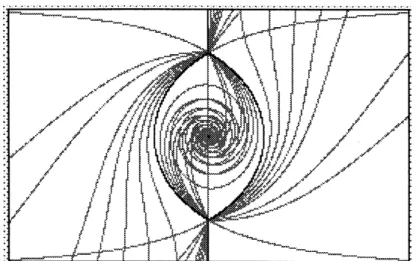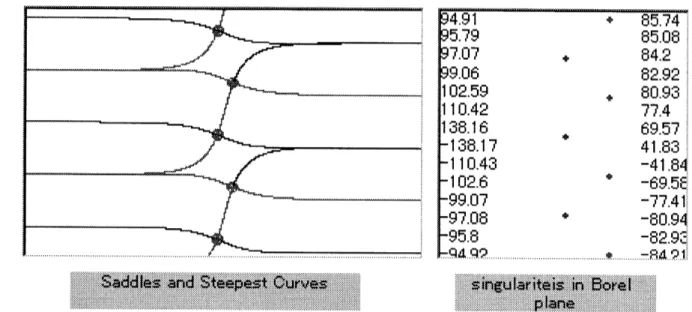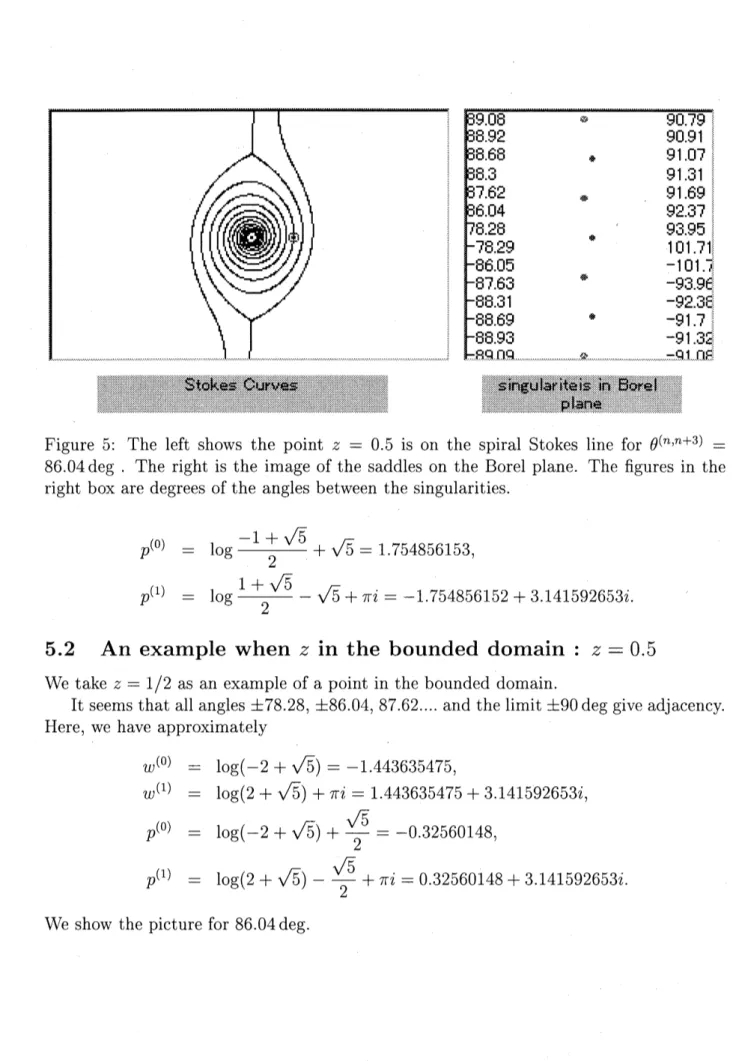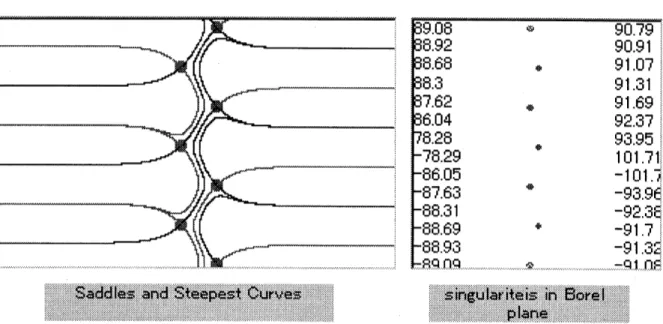Asymptotic
analysis
of
the
modified Bessel function
with
respect
to
the parameter
K\^oichi
UCHIYAMA
Department
of
Mathematics,
Sophia University, Tokyo, Japan
1
Introduction
This is an intermediate report of a joint work with William Boyd at Bristol University.
As the work is not yet completed, this talk is given in the author’s responsability.
The aim of this talk is to give
some
observation on adjacency of saddles concerninghyperasymptotic analysis to the modified Bessel function.
In the paper [3], W.Boyd derived a new representation of the gamma function,
ex-plointing hyperasymptotic analysis, that is, reformulation of the method of steepest de-scents by M. Berry and C. Howls in [1]. There appeared aseries of infinitely many saddles
lying on an adjacent contour in the integral representation of the gamma function. He
expected generalization of his analysis and proposed, as an example, the modified Bessel
function $K_{\nu}(\nu Z)$ when $\nu$ tends to infinity ([3] p628).
In this note, I explain the feature of the
case
of the modified Bessel function, whichturns out to be more complicated than that of the gamma function in [3]. In fact, there
appear two series of infinitely many saddles $w^{(2n)}(Z)$ and $w^{(2n+1}()z),$ $n\in N$. The
fun-damental step in the hyperasymptotic analysis of integrals with saddles is to determine
adjacency of saddles. In this report, our observation on adjacency relies on computer
graphics ofStokes lines and steepest descent
curves.
Our conjectural conclusion is:The complex $z$-plane is divided into the two regions, the unbounded domain (called
radial) and the bounded domain (called spiral) separated by a piecewise analytic bounded
closed
curve
(Figure $\mathit{2}(b)$)$1$
$\Re(\sqrt{1+z^{2}}+\log\frac{1-\sqrt{1+z^{2}}}{z})=0$.
(i) Suppose $z$ is in the unbounded (radial) domain. For any
fixed
$p$, only $w^{(\pm 1+)}p(Z)$ areadjacent to $w^{(p)}(z)$.
(ii) Suppose $z$ is in the bounded (spiral) domain. For any
fixed
$p,$ $w^{(p)}2n+1+(z)$ areadja-cent to $w^{(p)}(z)$
for
all $n$. $w^{(2n+p}()Z)$ are on the adjacent contour emanatingfrom
$w^{(p)}(z)$for
all $n$.Hyperasymptotic analisys has been developped by M.Berry, C.Howls, W.Boyd, $\mathrm{F}.\mathrm{W}$.J.
1Cf. the eye-shaped domain inOlver’s [7], Chap.10, 8.2, where the asymptotic analysis of themodified
Figure 1: The Stokes lines for vaious phases of$\nu$. The bounded Stokes lines from $i\mathrm{t}\mathrm{o}-i$
for ph $( \nu)=\pm\frac{1}{2}\pi$ are the boundary of the bounded (spiral) and the unbounded (radial)
domains.
Olver, A. Olde Daalhuis and others (See Boyd [4], Howls [6] also the reports given by C.
Howls and A. Olde Daalhuis in this symposium). E. Delabaere (e.g. [5]) gave an
inter-pretation by resurgent function theory. It seems an interesting problem to give rigorous
analysis of this example in view point of hyperasymptotic analysis or resurgent function
theory.
We review the several notations. The modified Bessel function $K_{\nu}(z)$ is the solution
to the equation
(1.1) $\frac{d^{2}K}{dz^{2}}+\frac{1}{z}\frac{dK}{dz}-(1+\frac{\nu^{2}}{z^{2}})K=0$,
defined by $K_{l\text{ノ}}(z)= \frac{\pi}{2}\frac{I_{-\nu}(z)-I_{\nu}(z)}{\sin\nu z}$ with $I_{\nu}(z)=e^{-i\nu\pi}/2J_{\mathcal{U}}(iz)$. When $\Re z$ is positive, it has
an integral representation
(1.2) $K_{\nu}(z)= \frac{1}{2}\int_{-\infty}^{\infty}e^{-\mathcal{U}}-z\mathrm{s}\mathrm{h}{}^{t}dtt\mathrm{c}\mathrm{o}$.
In this paper, we shall discuss the modified Bessel function $K_{\nu}(\nu Z)$ and related variants
for large complex $\nu$ and fixed complex $z$.
Our starting point is the integral reprentation (see e.g. [7] p.250, (8.03)) (1.3) $K_{\nu}( \nu Z)=\frac{1}{2}\int_{-\infty}^{\infty}e^{-\nu}d\{t+z\cosh t\}t$.
This is an integral, as we shall see, with infinite number of saddles The extended method of steepest descents [3], [1] is applicable. On the other hand, ifwe put $F(z)=K_{\nu}(\nu Z)$ for
fixed $\nu,$ $F(z)$ satisfies an second order differential equation
(1.4) $\frac{d^{2}F}{dz^{2}}+\frac{1}{z}\frac{dF}{dz}-\nu^{2}(1+\frac{1}{z^{2}})F=0$,
with a large complex parameter $\nu$. WKB analysis is applicable for asymptotic analysis
These two view points and their interplay are charactersitic in our arguments.
Acknowledgement: The author wish to express his appreciation to members at the
School ofMathematics, Universityof Bristol and also at theLaboratoryofJ.-A. Dieudonn\’e,
University ofNice for their interest and hospitality during his stay on sabbatical leave.
2
Infinite
number of saddles and
their
adjacency
2.1
Saddle points
We rewrite the integral representation of the modified Bessel function (2.5) $K_{\nu}( \nu z)=\frac{1}{2}\int_{-\infty}^{\infty}e^{-\nu p(z}’ w)dw$,
where
(2.6) $p(z, w)=w+z\cosh w$.
We
assume
always $z\neq 0$. This is a phase function of $w$ with a nonzero parameter $z$and we often omit $z$ to denote it simply by $p(w)$. The equation $p’(w)=0$ reduces to a
quadratic equation of$e^{w}$. We have
(2.7) $e^{w}= \frac{-1+\sqrt{1+z^{2}}}{z}$, $- \frac{1+\sqrt{1+z^{2}}}{z}$.
Therefore, we have two series of an infinite number of saddles (2.8) $w^{(2n)}$ $=$ $\log\frac{-1+\sqrt{1+z^{2}}}{z}+2n\pi i$,
(2.9) $w^{\prime_{\mathit{2}n+1)}}\backslash$
$=$ $\log\frac{1+\sqrt{1+z^{2}}}{z}+(2n+1)\pi i$,
where $n\in N$. We easily see that $p’(w)=p^{;\prime}(w)=0$ if and only if $w=(n+ \frac{1}{2})\pi\dot{i}$ and
$z=(-1)^{n_{i}}$. In this case, $p”(\prime w)=0$ is not satisfied. Hence, $\mathrm{o}\mathrm{n}\mathrm{l}\mathrm{y}\pm_{i}$ are the two double
saddles and the others
are
all simple.The points $z=\pm_{\dot{i}}$, where two simple saddles coalesce,
are
considered the turningpoints also in view point ofsteepest descents method.
We note that $e^{-w}= \frac{1\pm\sqrt{1+z^{2}}}{z}$ with the
same
choice of the double signaturesas
in $e^{w}$.We call their images by the map $p(\cdot)$ singularities on the complex $\xi$-plane. We have
two series of the infinite number of singularities$p^{(n)}=p(w^{(n)})$: (2.10) $p^{(2n)}$ $=$ $\log\frac{-1+\sqrt{1+z^{2}}}{z}+\sqrt{1+z^{2}}+2n\pi i$,
(2.11) $p^{(2n+)}1$ $=$ $\log\frac{1+\sqrt{1+z^{2}}}{z}-\sqrt{1+z^{2}}+(2n+1)\pi i$.
We note that
(2.12) $p^{(2n)}+p^{(1)}2m+=(2(n+m)+1)\pi i$.
Conjecture. Any two singulairities $p^{(n)}$ and $p^{(m)}$ for different $n,$ $m$ do not coalesce on the
2.2
Steepest
descents
For simplicity,
we
omit $z$ in the function$p(z, w)$. We put(2.13) $\theta=\mathrm{p}\mathrm{h}(\nu)$ and $p^{(n)}=p(w^{(n)})$.
We define
(2.14) $p^{(nm)}=p^{(m)}-p^{(n)}$, $\theta^{(nm)}=\mathrm{p}\mathrm{h}(p^{(nm)})$.
Following Berry and Howls’s computations in our context (see also Boyd [3]), we
consider
(2.15) $S^{(n)}( \nu)=\nu^{\frac{1}{2}}\int_{C^{(n)}}(\theta)p\exp(-\nu[(w)-p](n))dw$,
where $C^{(n)}(\theta)$ is the path ofsteepest descent for $\theta$ passing through $w^{(n)}$. We define Stokes
lines in view point of steepest descents method by the locus of $\{z\in C;\propto s[\nu p^{(n})(z)]=$
$s^{\infty}[\nu p^{()}m(z)]\}$ for
some
different integers $n$ and $m$. It is readily reduced to the case where$n$ and $m$ have different parity, say, $n$ is even and $m$ is odd.
Proposition 2.1 Stokes lines in viewpoint
of
steepest descents methodsatisfies
thesamedifferential
relationsatisfied
by thosedefined
by the $WKB$ method.We give description of paths of steepest descents. We introduce real variables, $z=$
$x+\dot{i}y$ for the independent variable of the differential equation, $\theta$ for the phase of the
asymptotic parameter $\nu$ and $w=u+iv$ for the integration variable.
Proposition 2.2 Thepaths
of
steepest descents or ascents $satiSf\sim vthe$differential
equation(2.16) $g(u, v)\dot{u}+f(u, v)\dot{v}=0$
where
$f(u, v)$ $=$ $\cos\theta+\frac{1}{2}\{e^{u}(x\cos(\theta+v)-y\sin(\theta+v))$
(2.17) $+e^{-u}(x\cos(\theta-v)-y\sin(\theta-v))\}$ ,
$g(u, v)$ $=$ $\sin\theta+\frac{1}{2}\{e^{u}(x\sin(\theta+v)+y\cos(\theta+v))$
(2.18) $-e^{-u}(X\sin(\theta-v)-y\cos(\theta-v))\}$
.
REMARK 1. If we choose $\beta$ such that $\cos\beta=x/\sqrt{x^{2}+y^{2}}$ and $\sin\beta=y/\sqrt{x^{2}+y^{2}}$,
we
have(2.19) $f(u, v)$ $=$ $\cos\theta+\frac{\sqrt{x^{2}+y^{2}}}{2}\{e^{u}\cos(\theta+v+\beta)+e^{-u}\cos(\theta-v+\beta)\}$
(2.20) $g(u, v)$ $=$ $\sin\theta+\frac{\sqrt{x^{2}+y^{2}}}{2}\{e^{u}\sin(\theta+v+\beta)-e^{-u}\sin(\theta-v+\beta)\}$ .
REMARK 2. The differential relation is invariant for translation of$2\pi$ in $v$-variable. The
We give approximatedescription ofpaths ofthe steepest
near
simplesaddles by Taylorexpansion. This approximation is used as initial step in the numerical integration of the
differential relation.
Let $w^{(n)}$ be a simple saddle. Then,
$p(w)$ $=p(w^{(n)})+p’(w^{(})n)(w-w^{(n}))+ \frac{p’’}{2!}(w-w^{(})^{2}n)+O((w-w^{(n})^{3}))$
$=p(w^{(n)})+ \frac{(-1)^{n}}{2}\sqrt{1+z^{2}}(w-w^{(})^{2}n)+^{o}((w-w)(n)3)$ .
Hence, if$w$ in on the locus of$s^{\infty}[p(w)]=\infty s[p(w^{(n)})]$,
we
have approximately,$\theta+2\mathrm{p}\mathrm{h}(w-w^{(})n)+\mathrm{P}\mathrm{h}(\nu p’(\prime w^{(})n))=m\pi$,
where $m$ is an integer. The linear approximation of the paths of the steepest near
$w^{(n)}$ is
given by
(2.21) $\mathrm{p}\mathrm{h}(w-w^{(})n)=-\frac{\theta}{2}-\frac{\mathrm{p}\mathrm{h}((-1)n\nu\sqrt{1+z^{2}})}{2}+\frac{m}{2}\pi$, $m=0,1,2,3$ ,
which does not depend on $n$ as a set of four lines.
We define the domain $\triangle(n)$. We consider all the steepest-descent paths, for different $\theta$,
which emanate from the saddle point $w^{(n)}$. They sweep out the domain surrounded by
a finite or infinite number of steepest-descent paths $C^{(m)}(-\theta^{(nm)})$ passing through $w^{(m)}$,
called adjacent contour. This domain is denoted by $\triangle(n)$. The saddles $w^{(m)}$ are called
adjacent to the saddle $w^{(n)}$. They
are
hit by the steepest descent path $C^{(n)}(-\theta^{(nm)})$issuing from the $w^{(n)}$.
2.3
Review of hyperasymptotic representation
We recall the hyperasymptotic formula given by M.Berry-C. Howls [1]. We
use
thesame
notations as in previous sections.
Let $\Gamma^{(n)}$ be
a
finite loop in $\triangle(n)$ surrounding a part of $C^{(n)}$ including the two zeros ofthe denominator ofthe integrand.
The basis for hyperasymptotics is the following
resurgence
formula:(2.22) $S^{(n)}(\nu)$ $=$ $\sum_{r=0}^{N-1}\frac{a_{r}^{(n)}}{\nu^{r}}+R_{N}^{(n)}(\nu)$,
$a_{r}^{(n)}$ $=$ $\frac{\Gamma(r+\frac{1}{2})}{2\pi\dot{i}}\int_{\mathrm{r}^{(n})}\frac{1}{[p(w)-p^{(}]^{r}n)+1/2}dw$,
$R_{N}^{(n)}(\nu)$ $=$ $\frac{1}{2\pi i\nu^{N}}\sum_{m}\frac{1}{(p^{(nm)})^{N}}\int_{0}^{\infty}\frac{\sigma^{N-1-\sigma}e}{1-\frac{\sigma}{\nu p^{(nm)}}}s(m)(\frac{\sigma}{p^{(nm)}})d\sigma$,
where $w^{(m)}$
are
adjacent saddles to $w^{(n)}$.This is a review ofgeneral theory in
our
context.Proposition 2.3 (2.23) $S^{(2n)}.(\nu)$ $=$ $S^{(0)}(\nu)$ (2.24) $S^{(2n+}1)(\nu)$ $=$ $S^{(1)}(\nu)$ We notice (2.25) $p^{(2}n,2n\pm 1)$ $=$ $-2p^{(0)}\pm\pi i$, (2.26) $p^{(0,\pm(2}m+1))$ $=$ $-2p^{(0)}\pm(2m+1)\pi$.
In this note, we will not discuss the analytic formulas in detail.
3
Stokes lines
In this section, we discuss Stokes lines of the equation in view point ofWKB analysis. We
assume
the WKB formal expansion(3.1) $F(z)=e^{-\nu S(}z)n= \sum a(nZ)\nu\infty 0-n$.
Substitutingthis into the equation and rearranging the result by the power of$\nu$, we obtain
the relation of the highest order
(3.2) $\nu^{2}\{(\frac{dS}{dz})^{2}-(1+\frac{1}{z^{2}})\}=0$.
Hence, we have
(3.3) $S(z)= \pm\int_{z_{0}}^{z}\frac{\sqrt 1\overline{+\zeta^{2}}}{\zeta}d\zeta$,
where $z_{0}$ isan arbitrary initial pointexcept the origin. Then wehave $a_{0}(z)=C(1+z^{2})^{-1}/4$,
although we do not need it for
our
analysis. We choose $i$ or $-i$as
$z_{0}$, which isone
of theturning. points of the equation and define the Stokes lines from the turning point $z_{0}$. We
consider three cuts on the complex plane, two along a half straight line starting from the
turning points and the other from the origin. We put on this cut plane
(3.4) $S_{j}(z)=(-1)^{j-1} \int_{z}0\frac{\sqrt{1+\zeta^{2}}}{\zeta}d\zeta z$, for $j=1,2$ ,
where $\sqrt{1}=1$ in the integrand. Then, Stokes lines of the equation
issuing from the
turning point $z_{0}$
are
definedas
the analitically continued locus(3.5) $\{z\in C;\propto s[\nu S_{1}(z)]=s[\propto\nu S2(_{Z})]\}$,
that is,
where by definition
(3.7) $\theta=\mathrm{p}\mathrm{h}(\nu)$.
Stokes lines
are
locallysmooth curves except the turning points as singularities. Denotinglocally
one
of the Stokes lines by $z(\sigma)$ withone
dimensional real parameter a, we have adifferential relation of$z(\sigma)$.
Proposition 3.1 Outside the turning points, any analytically continued Stokes line $z(\sigma)$
satisfies
(3.8) $s^{\infty}[e^{i\theta} \dot{z}(\sigma)\frac{\sqrt{1+z(\sigma)2}}{z(\sigma)}]=0$ .
This differentialrelation will be numerically integrated and give graphical imformation
of the Stokes lines. We put
(3.9) $\frac{\sqrt{1+z^{2}}}{z}=P(x, y)+iQ(x, y)$.
Then the differential relation has the form
(3.10) $\dot{y}(P(x, y)\cos\theta-Q(X, y)\sin\theta)+\dot{x}(P(x, y)\sin\theta Q(x, y)\cos\theta)=0$.
In $(x, y)$-coordinates, the points $(0,1),$ $(0, -1),$ $(0,0)$ are singularities of the vector field,
corresponding to the turning points $z=i,$ $-i$ and the pole $z=0$. All the pictures of
Stokes lines are obtained by approximate integration of the vector field by the
Runge-Kutta method, starting from a small neighbourhood of the turning points.
On the other hand, the $\frac{\sqrt{1+z^{2}}}{z}$ in (3.6) has a primitive
$\sqrt{1+z^{2}}+\log\frac{1-\sqrt{1+z^{2}}}{z}$.
We fix the branches as $\sqrt{1}=1$ and $\log\frac{1-\sqrt{1+z^{2}}}{z}=\mp\frac{\pi}{2}\dot{i}$ when $z– \exp(\pm\frac{\pi}{2}i)$. Therefore,
the equation in (3.6) for $z_{0}=\dot{i}$ is
(3.11) $\propto s[e^{i\theta}(\sqrt{1+z^{2}}+\log\frac{1-\sqrt{1+z^{2}}}{z}+\frac{\pi}{2}\dot{i})]=0$,
and the other one for $z_{0}=-i$ is
(3.12) $\propto s[e^{i\theta}(\sqrt{1+z^{2}}+\log\frac{1-\sqrt{1+z^{2}}}{z}-\frac{\pi}{2}\dot{i})]=0$.
Graphics of Stokes lines from $\dot{i}$ and from $-\dot{i}$ show point-symmetry with respect to the
origin $z=0$. This symmetry reflects that if$z$ satifies the first equation, then $ze^{\pi i}$ satisfies
the (analytically continued around the origin) second equation and that the
converse
isalso true.
We
can
verify analytically several factsseen
by the figures obtained by numerical(S1) If $z$ tends to $\infty$ along a Stokes line, $\theta+\mathrm{p}\mathrm{h}(z)$ is asymptotically $0$ or $\pi$ mod $2\pi$.
(S2) Approximate description near the turning points: we have asymptotically
(3.13) $\mathrm{p}\mathrm{h}(z-i)=\frac{\pi}{6}-\frac{2}{3}\theta+\frac{2}{3}n\pi$,
where $n$ is
an
arbitrary integer.For example, if$\theta=0$, the asymptotic directions ofStokes lines issuing from $\dot{i}$
are
$\frac{\pi}{6},$ $\frac{5}{6}\pi,$ $- \frac{\pi}{2}$.
We have the symmetric result for the case $z_{0}=-i$. They are used as the first step from
the turning points for the numerical integration of the differential relation (3.11).
(S3) Approximate description near the pole is a conformal image ofa logarithmic spiral.
(S4) Existence of finite closed Stokes lines when $\theta=\pm\frac{\pi}{2}$. In this case, the two equations
(3.11) and (3.12) are equal to
(3.14) $\Re[\sqrt{1+z^{2}}+\log\frac{1-\sqrt{1+z^{2}}}{z}]=0$.
The two Stokes lines connecting $\pm_{i}$ consist of the boundary of a bounded domain. We
call this bounded domain spiral, since it is filled with spiral Stokes lines issuing $\mathrm{f}\mathrm{r}\mathrm{o}\mathrm{m}\pm i$
as $\theta$ changes from $0$ to $\pm\frac{\pi}{2}$ (See Figure 1, Figure $2(\mathrm{b})$). The interior of the complement
will be called radial.
4
Discussion
on
adjacency
Integrating numerically by a simple version of Runge-Kutta method the differential
rela-tions in the previous secrela-tions, we can observe steepest descent curves and Stokes lines by computer graphics $([8])[9])$.
When we follow faithfully the definition of adjacency, we have to verify whether steep-est descent
curves
issuing from one saddle $w^{(n)}$ hit or not another saddle for a certainphase of$\nu$. Since adjacency of saddles $w^{(m)}$ to $w^{(n)}$ is transformed into visibility between
the corresponding two singularities$p^{(m)}$ and $p^{(n)}$ on the Borel plane, the critical phase of
$\nu$ is the angle $-\theta^{(nm)}$, if the they are on the same Riemann sheet over the Borel plane.
Let the steepest descent $C^{(n)}(-\theta^{(nm)})$ passing through $w^{(n)}$ hit the saddle $w^{(m)}$. This
measns
that we have Stokes phenomenon with respect to $\theta$ near $-\theta^{(nm)}$ while$z$ is fixed.
The
same
steepest descent picture means also that we have Stokes phenomenon withrespect to $z$ when the phase $-\theta^{(nm)}$ is fixed. Hence, in order to know adjacency, we have
only to verify whether $z$ is
on
the Stokes line by the exact WKB method ([10]) with thephase $-\theta^{(nm)}$.
We observe that if$z$ is inside the spiral domain, $z$ is passed over infinitely many times
by spiral Stokes lines when $\theta$ changes from
$0 \mathrm{t}\mathrm{o}\frac{\pi}{2}$ or $\frac{-\pi}{2}$. This must induce infinite number
of adjacent saddles when $z$ is in the spiral domain. On the other hand, the domain outside
Figure 2: (a) and (b).
four times modulo $2\pi$ by the radial Stokes lines issuing from $\pm_{\dot{i}}$ as $\theta$ changes. We
are
convinced of the following conjectural conclusion through the observation of graphics.
(i) Suppose$z$ is in the radial domain. For any
fixed
$p$, only $w^{(\pm 1+p)}(z)$ are adjacent to$w^{(p)}(_{Z)}$.
$(\dot{i}i)$ Suppose $z$ is in the spiral domain. For any
fixed
$p,$ $w^{(p)}2n+1+(z)$ are adjacent to$w^{(p)}(z)$
for
all $n$. $w^{(2n+p)}(z)$ are on the adjacent contour emanatingfrom
$w^{(p)}(z)$
for
all$n$.
A similar situation to the first case (i) has already appeared in Boyd [2]. The second
situation
seems
new and very much different from the Gamma functioncase.
When $z=$
0.662743..
with the phase $\frac{1}{2}\pi$, all saddles are connected by one zig-zagsteepest descent
curve.
This picture recallus
ofa double Stokes phenomenon $([8],[9])$.5
Examples
of
adjacent
saddles
5.1
An
example
with
$z$in
the
unbounded domain:
$z=2$We take $z=2$ as an example of a point in the
unbounded
domainTo verify adjacency ofsaddles, we don’t need to check all angles. (It is impossible for the computer!) We have only to verify the steepest
curves
when $\theta=\mathrm{p}\mathrm{h}(p^{(mn)})$. Noticethat there exist (
$‘ \mathrm{h}\mathrm{o}\mathrm{r}\mathrm{i}\mathrm{z}\mathrm{o}\mathrm{n}\mathrm{t}\mathrm{a}\mathrm{l}$” steepest descent
curves
prevent from adjacency of saddlesexcept the pair $w^{(n)}$ and $w^{(n\pm 1)}$. The
reason
why $w^{(n)}$ is adjacent only to $w^{(n\pm 1)}$ isseen
by the fact that the point $z=2$ is exactly on a Stokes line $\mathrm{f}\mathrm{o}\mathrm{r}\pm\theta^{(n\pm 1,n)}$
i.e. $\pm 41.83$ and
$\pm 138.16\deg$ (rounded).
Here,
we
have approximately$w^{(0)}$ $=$ $\log\frac{-1+\sqrt{5}}{2}=-0.481211825$,
Figure 3: The left shows the point $z=2$ is exactly on the radial Stokes line for $\theta=$
41.84$\deg$ (rounded). The right is the image of the saddleson the Borelplane. The figures
in the right box are degrees of the angle between the singularities.
Figure 4: The left is a figure of saddles and steepest
curves
for $\theta^{(n,n-1}$)$=$
-41.84
$\deg$(round) when $z=2$. The right is the image ofthe saddles onthe Borel plane. The figures in the right box
are
$\mathrm{d}\mathrm{e}\mathrm{g}$.rees
of the angle between the singularities.Figure 5: The left shows the point $z=0.5$ is on the spiral Stokes line for $\theta^{(n,n+3}$) $=$
86.04$\mathrm{d}\mathrm{e}\mathrm{g}$
.
The right is the image of the saddles on the Borel plane. The figures in theright box are degrees of the angles between the singularities.
$p^{(0)}$ $=$ $\log\frac{-1+\sqrt{5}}{2}+\sqrt{5}=1.754856153$,
$p^{(1)}$ $=$ $\log\frac{1+\sqrt{5}}{2}-\sqrt{5}+\pi\dot{i}=-1.754856152+3.141592653\dot{i}$.
5.2
An
example when
$z$in
the bounded domain
:
$z=0.5$We take $z=1/2$ as an example of a point in the bounded domain.
It seems that all $\mathrm{a}\mathrm{n}\mathrm{g}\mathrm{l}\mathrm{e}\mathrm{s}\pm 78.28,$ $\pm 86.04$, 87.62.... and the$\mathrm{l}\mathrm{i}\mathrm{m}\mathrm{i}\mathrm{t}\pm 90\deg$ give adjacency.
Here, we have approximately
$w^{(0)}$ $=$ $\log(-2+\sqrt{5})=-1.443635475$,
$w^{(1)}$ $=$ $\log(2+\sqrt{5})+\pi i=1.443635475+3.141592653i$, $p^{(0)}$ $=$ $\log(-2+\sqrt{5})+\frac{\sqrt{5}}{2}=-0.32560148$,
$p^{(1)}$ $=$ $\log(2+\sqrt{5})-\frac{\sqrt{5}}{2}+\pi i=0.32560148+3.141592653i$.
Figure6: The left is afigure of saddles andsteepest curvesfor $\theta^{(n,n+)}\mathrm{s}=86.04\deg$ (roughly
rounded). Thesteepest descents creep up from the saddles $w^{(n)}$ to hit the adjacent saddles $w^{(n+3)}$.
A
Transcendental
equations
Conjecture. Any two singulairities$p^{(n)}$ and $p^{(m)}$ for different
$n,$ $m$ do not coalesce on the
$\xi$-plane, when $z\neq\pm i$.
More precisely, we put cuts in $z$-plane from $i$ to $\infty$ and from $-i$ to $\infty$ along the
imaginary axis to uniformize $\sqrt{1+z^{2}}$ with $\sqrt{1}=1$. We should consider the possibility $p^{(2n)}=p^{(1)}2m+$ for some integers $n$ and $m$. It means
$\log\frac{-1+\sqrt{1+z^{2}}}{-1-\sqrt{1+z^{2}}}+2(n-m)\pi i+2\sqrt{1+z^{2}}=0$,
which is equivalent to
$2\sqrt{1+z^{2}}-2-Z^{2}=z^{2}e^{-2\sqrt{1+z^{2}}}$. By change of variable $s=\sqrt{1+z^{2}}$, this is
$(s^{2}-1)e^{-}+2(_{S^{2}+}4S1)e-2S+(S^{2}-1)=0$,
which reduces to the equation
(A. 1) $(s+\tanh s)(s-\tanh_{S)}=0$.
Our conjecture is that $s=0$ is a unique solution of $(\mathrm{A}.1)_{\mathrm{C}\mathrm{O}}\mathrm{r}\mathrm{r}\mathrm{e}\mathrm{s}\mathrm{P}^{\mathrm{o}}\mathrm{n}\mathrm{d}\mathrm{i}\mathrm{n}\mathrm{g}$ to $z^{2}=-1$.
References
[1] M.Berry and C.Howls, Hyperasymptotics for integrals with saddles, Proc. R. Soc.
[2] W. Boyd, Error bounds for the method of steepest descents, Proc. R. Soc. London
A 440,(1993),
493-518.
[3] W. Boyd, Gamma function asymptotics by an extension of the method of steepest
descents, Proc. R. Soc. London A 447, (1994),
609-630
[4] W. Boyd, Recent developments in asymptotics obtained via integral representations
of
Stieltues-transform
type, RIMS Kokyuroku 968, (1996), 1-30[5] E. Delabaere Un peu d’asymptotique, Lecture Note at University of Nice
Sophia-Antipolis, DEA
96-97
[6] C.J. Howls, An Introduction to Hyperasymptotics using Borel-Laplace Transforms,
RIMS Kokyuroku 968, (1996), 31-48
[7] F.W.J. Olver Asymptotics and special functions, Academic Press, 1974, 2nd version
1997, New York
[8] K. Uchiyama, On examples of Voros analysis in complex WKB theory, “M\’ethodes
r\’esurgentes’’ ed. by L. Boutet de Monvel, Hermann, 1994,
115-134.
[9] K. Uchiyama, Graphical illustration ofnew Stokes line for integrals with saddles. An
informal seminar in the workshop ”Exponential Asymptotics” at Cambridge, 1995,
March
[10] A. Voros, The return of the quarticoscillator, The complexWKBmethod, Ann. Inst.



